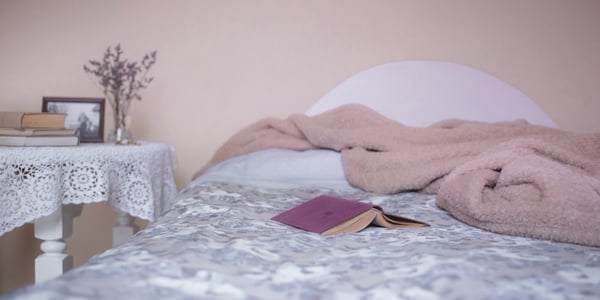Tightening your abdominal muscles to strengthen your core does not relieve chronic back pain. It is...
3 Reasons to Stand and Stretch Right Now
According to the World Health Organization (WHO), around 33% of the global population, including seniors, suffer from musculoskeletal conditions. One in two older adults in the US lives with painful disorders related to muscles. The prevalence of musculoskeletal problems in the country is the same as chronic respiratory and cardiovascular conditions.
The loss of physical independence and mobility is a devastating experience for older adults. Some of the common disorders include fractures, osteoporosis, infections, osteoarthritis microcrystal disorders, and tumors.
Although older adults undergo conservative treatments, such as pain medications, antidepressants, and analgesics to treat these problems, research highlights that stretching exercises offer adverse-free and long-term benefits to older adults. In today's article, we will talk about the importance and benefits of stretching for the elderly.
The Importance of Stretching for Older Adults
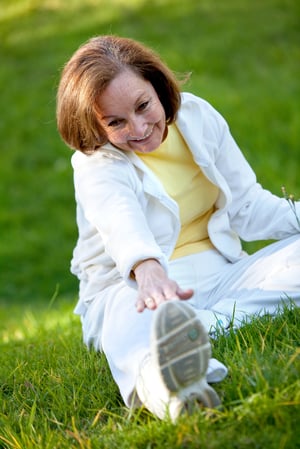 It is not easy for older over the age of 55 to maintain mobility. As we age, our muscles and joints weaken. Mobility deteriorates due to friction in our joints, lower metabolism in muscle cells, and osteoporosis, a condition characterized by weak and brittle bones.
It is not easy for older over the age of 55 to maintain mobility. As we age, our muscles and joints weaken. Mobility deteriorates due to friction in our joints, lower metabolism in muscle cells, and osteoporosis, a condition characterized by weak and brittle bones.
Stretching offers a wide range of benefits to older adults, such as strengthening muscles, improved flexibility, and increased blood flow to muscles, ligaments, and tissues. Some studies show that stretching exercise improves oxygenated blood flow to the brain, causing it to release stress-suppressing chemicals, such as dopamine and serotonin.
Stretching increases circulation, blood flow, strengthens muscles, increases mobility, improves posture, releases tension, boosts energy levels, and reduces the risk of falls and accidents. As a result, you have a better quality of life, improved overall wellbeing, and healthy aging. Next, we talk about the benefits of stretching. Continue reading!
-
Reduces Spinal Pain and Arthritis
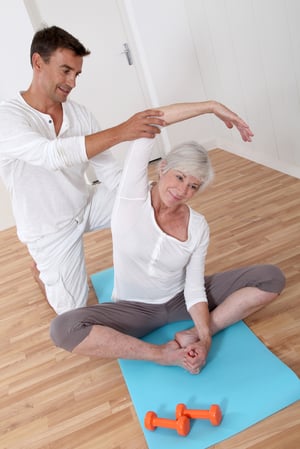 Research highlights that spinal stenosis and osteoarthritis are two common causes of lower back pain in older adults. Osteoarthritis is a common degenerative disease and a form of arthritis characterized by degeneration of soft connective tissues and cartilage between the facet joints. According to the Centers for Disease Control and Prevention (CDC), osteoarthritis affects over 12 million older adults in the US.
Research highlights that spinal stenosis and osteoarthritis are two common causes of lower back pain in older adults. Osteoarthritis is a common degenerative disease and a form of arthritis characterized by degeneration of soft connective tissues and cartilage between the facet joints. According to the Centers for Disease Control and Prevention (CDC), osteoarthritis affects over 12 million older adults in the US.
As a result, you will feel pain in your lumbar spine (lower back). Although the pain comes and goes depending on your health and muscle strength, not treating it can lead to something more severe, such as sciatica, pain radiating from your lower back through the hips to one of your legs. Besides, osteoarthritis also develops in the knees, hips, fingers, toes, and neck.
Spinal stenosis is another painful condition that leads to the narrowing of bone structures in the back. The spinal nerves' compression causes different symptoms, such as weakness, numbness, tingling, and sciatica in the lumbar spine, hips, and legs. Although both osteoarthritis and spinal stenosis occur naturally as you age, you can manage the resulting pain by performing stretching exercises, which offer:-
Increased range of motion
-
Improved flexibility and elasticity
-
Reduced stiffness in discs and joints
Experts recommend warming up your stiff muscles before performing stretching exercises. You can use a heat pack for this purpose, and likewise, you would need an ice pack to cool down your muscles once you are done with exercises. The goal is to mitigate the effects of inflammation in your joints.
-
-
Decreased Risk of Falling and Accidents
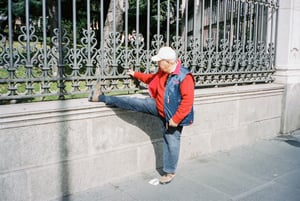 Although the risk of falling is not a significant concern for people between the age of 55 and 60, it can severely affect senior citizens above the age of 65. The CDC reported that over 30% of older adults (one out of three) will fall or have accidents in the US every year.
Although the risk of falling is not a significant concern for people between the age of 55 and 60, it can severely affect senior citizens above the age of 65. The CDC reported that over 30% of older adults (one out of three) will fall or have accidents in the US every year.The report highlighted that more than 2.5 million older adults need treatment in specialized emergency facilities every year. A growing body of research evidence shows that regular bouts of stretching are essential for older adults.
Stretching exercises improve stability, maintain posture, and create balance, preventing falls. Moreover, stretching improves flexibility in the lower back, quadriceps, and hamstrings and increases mobility in the hip joints to prevent falling in older adults. -
Improved Balance and Posture
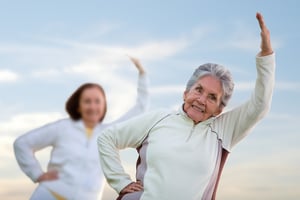 As we age, the water content in connective tissue decreases, leading to reduced flexibility and elasticity in ligaments and tendons. When ligaments and tendons tighten, it causes posture problems, and it increases difficulty standing, sitting, and sleeping.
As we age, the water content in connective tissue decreases, leading to reduced flexibility and elasticity in ligaments and tendons. When ligaments and tendons tighten, it causes posture problems, and it increases difficulty standing, sitting, and sleeping.
Poor posture is characterized by a forward head posture, forward pressing hips, and rounded upper back and shoulders. Due to the compression of S-curvature in your spine, it causes pain in the lumbar spine and shoulder blades.Stretching exercises improve posture and loosen tight muscles, tendons, and ligaments. As a result, you have a greater range of motion due to increased blood circulation to these areas.
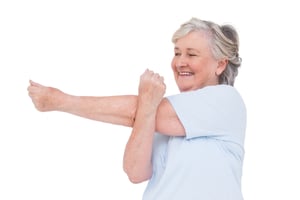 Doctors and physiotherapists recommend dynamic stretching exercises like arm swings, lunges, shoulder circles, half squats, and leg swings for older adults. These exercises improve posture and increase range of motion by streamlining blood flow and boosting energy levels in tissues
Doctors and physiotherapists recommend dynamic stretching exercises like arm swings, lunges, shoulder circles, half squats, and leg swings for older adults. These exercises improve posture and increase range of motion by streamlining blood flow and boosting energy levels in tissues
Regular stretching is an excellent way to manage symptoms of arthritis, back pain, and other associated disorders or complications. If you are above the age of 55, make sure you perform stretching exercises under the guidance or according to your doctor or physiotherapists' instructions. You will likely see changes in your body within a few weeks or months, including improved posture, increased energy levels, and reduced falls.
Ready to get stretching? Try these 5 stretches today!
Related Content:






